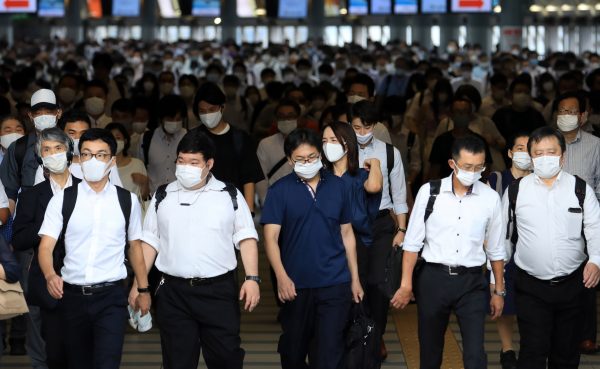Japan’s unemployment rate was low before the pandemic, sitting below 2.5 per cent due to labour shortages caused by population decline. Since January, the unemployment rate has risen slowly, reaching 2.9 per cent in July — still extremely low compared to other countries. COVID-19’s effect on the Japanese labour market appears to be minimal so far.
But the number of furloughed employees is a more informative metric on the health of the Japanese labour market. In April, the government declared a countrywide state of emergency, leaving the majority of service sector workers furloughed or unemployed. From March to April, the rise in the number of furloughed workers was significantly greater than in unemployed workers. If furloughed workers were counted as unemployed, the Japanese unemployment rate in April would have stood at 11.5 per cent.
Japan’s short-time work compensation scheme is the primary reason for the large increase in furloughed workers relative to unemployed workers. This system allows businesses to continue to employ furloughed workers by partially subsidising employee wages, preventing a drastic deterioration in labour market conditions during recessions.
As part of its emergency response to COVID-19, the Japanese government further increased the maximum claimable subsidies from April to September this year. This prevented a surge in the unemployment rate. Since the state of emergency was lifted at the end of May, the number of furloughed workers began falling. But June statistics reveal that 7 per cent of employees who were furloughed as of May had since become unemployed.
The emergency COVID-19 subsidies in the short-time compensation scheme was extended until this December. But a second spike in infections accompanied by another suspension of economic activity could result in an immediate rise in the unemployment rate. With the possibility of a protracted struggle against COVID-19, Japan may have to confront an unprecedented rise in the rate of unemployment. Staving off this potential rise is thus an urgent problem.
The Japanese labour market has experienced very low unemployment for decades. Widespread job losses and low consumer confidence will reduce consumption, leading to economic malaise. The government is currently facing a budget problem, but a further extension of wage subsidies until at least March 2021 might be prudent given the high possibility of COVID-19 outbreaks recurring during winter.
Meanwhile, there has been a rise in the demand for essential workers. In April, companies collaborated across sectors to adopt a framework enabling the temporary transfer of workers between industries and occupations. For example, some restaurant and bar workers were temporarily deployed to supermarkets and grocery stores.
While this scheme was limited in scale, some local authorities recently started job-matching services to expand its capacity. The system is capable of matching workers to jobs across different industries and may prove to be critical in preparing the economy for future spikes in infection.
Japan has also seen a rapid adoption of telework (remote work). The government had promoted telework prior to COVID-19 as part of its work-style reforms but take-up was slow. But the state of emergency spurred a large number of companies to implement telework. The Japanese government’s Cabinet Office surveyed 10,000 people on behavioural changes during the COVID-19 pandemic and reported that 34.5 per cent of respondents had taken up remote work since the beginning of the pandemic.
Among those who have worked from home, 35 per cent across Japan and about half of those living in the Greater Tokyo Area reported that they would like to continue telework in future. A common reason given was avoiding lengthy commutes in Tokyo. On average, a full-time Japanese worker’s daily commute takes 71.8 minutes. Reallocating this time to resting, sleeping or spending time on oneself or with family likely constitutes a major change to the lives of many Japanese people.
Still, a variety of problems with telework have emerged. There is a lack of standards around and experience in conducting telework, resulting in poor productivity, as well as communication and infrastructural issues. In the same Cabinet Office survey, 15 per cent of people also cited ‘overwork due to the blurring of boundaries between work and life’ as a problem. This has led to particular anxiety among Japanese workers, who function in a culture where long working hours are normal. One trade union survey reported that over 50 per cent of workers sometimes worked longer hours at home than before COVID-19 prompted them to take up teleworking.
Overwork has been a decades-long problem in Japan. In April 2019, the government revised the Labour Standards Act, introducing maximum limits for overtime, with penalties attached. Companies are required to stringently monitor their employees’ working hours and preserve employee health. With these reforms, the proportion of employees working over 60 hours per week has gradually fallen. But these reforms were based on pre-COVID-19 work patterns of commuting to the workplace.
With the rapid adoption of telework, Japan needs to confront its problem of long working hours again. Introducing ‘right to disconnect’ regulations would restore boundaries between home and the office. When it comes to telework, companies’ capability to closely monitor working hours and take responsibility for their employees’ health is limited.
COVID-19 presents an opportunity to demand a thorough reassessment of the way that work is conducted, including clarifying job descriptions and authority, transferring discretionary power to the field level and eliminating redundant work. This will improve worker productivity and mitigate incentives for working long hours.
Sachiko Kuroda is Professor of Economics in the Faculty of Education and Integrated Arts and Sciences, Waseda University.
An extended version of this article appears in the most recent edition of East Asia Forum Quarterly, ‘Japan’s Choices’, Vol. 12, No. 3.

